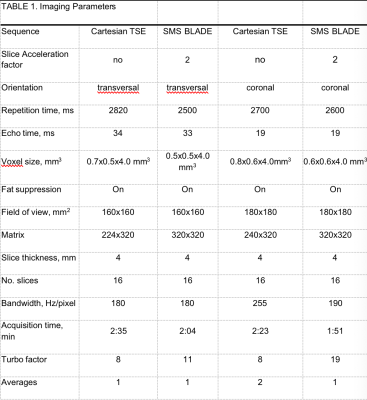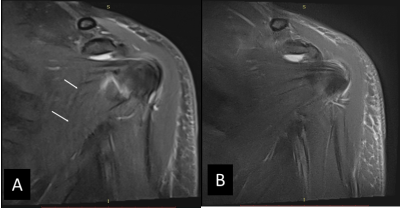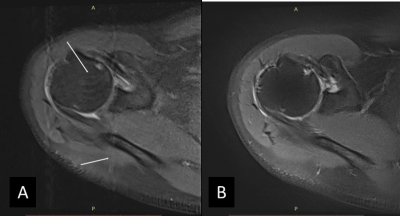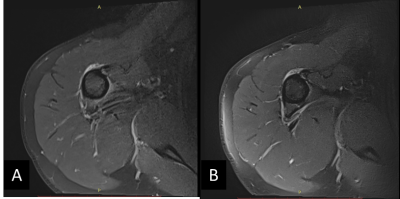2789
The Feasibility of the Simultaneous Multi-slice BLADE Technique in Shoulder Imaging1Department of Radiology, Henan Provincial People’s Hospital, Zhengzhou, China, 2Siemens Shenzhen Magnetic Resonance Ltd.,, Shenzhen, China, 3MR Collaboration, Siemens Healthcare Ltd.,, Shenzhen, China
Synopsis
The purpose of this study was to evaluate the use of Simultaneous Multi-slice BLADE technique for artifact reduction and overall image quality improvement of the shoulder. All the patients underwent the conventional TSE and SMS BLADE sequences. The images were graded by two radiologists for image artifacts, overall image quality, and delineation of anatomic structure. The results showed that the new technique can significantly reduce artifacts, shorten scanning time, improve overall image quality, display more detailed anatomical structures and provide better clinical diagnostic images than conventional shoulder joint sequence.
Introduction
Recently, a fast imaging technique called the simultaneous multi-slice (SMS) or multiband (MB) technique has emerged, and it can significantly reduce the image acquisition time with a low signal-to-noise penalty [1-4]. Several studies have shown the benefit of PROPELLER or BLADE for reducing motion artifacts [5]. In our study, we combined the advantages of SMS acceleration with the motion correction and artifact reduction capabilities of the BLADE technique. The aim of this study was to evaluate the clinical value of combined SMS and BLADE sequences (SMS BLADE) in shoulder imaging by comparing the image quality, detection rate of lesions, and scanning time with the conventional TSE sequences.Methods
The study was approved by the institutional ethics committee. Forty-two patients (18 men and 24 women; mean age, 48.4 years, range: 18 – 81 years) were examined using a 1.5T scanner (MAGNETOM Sempra, Siemens Shenzhen Magnetic Resonance Ltd., China) with an 8-channel shoulder phased-array coil. All patients underwent fat-saturated proton density–weighted imaging using Cartesian-TSE and prototype SMS BLADE sequences in oblique coronal and axial orientations. The key parameters are shown in Table 1. Two radiologists rated image quality (IQ) on a 5-point scale. The Wilcoxon signed-rank test was used to compare the data of the standard and SMS BLADE images. Moreover, the sensitivity, specificity, and accuracy of the SMS BLADE sequences for shoulder joint lesions were calculated using the conventional sequences as the standard reference. The significant differences in the two sequences were compared using the McNemar test. P < 0.05 was considered statistically significant.Results
The scan acquisition time was reduced by approximately 20%, whereas the spatial resolution was maintained. The overall image quality score of the SMS BLADE sequence was significantly higher (p < 0.001), and the motion artifacts in the SMS BLADE images were significantly reduced (p < 0.001) compared to the Cartesian-TSE. There was no statistical difference between the two sequences in the detection of shoulder joint lesions (p > 0.05). Compared with the Cartesian-TSE sequence, the sensitivity, specificity, and accuracy of the SMS BLADE sequence for detecting lesions were 94.7%, 100%, and 95.6%, respectively.Conclusion
This study demonstrated that SMS BLADE technology for shoulder MRI can reduce artifacts and improve the overall image quality compared to Cartesian-TSE sequences. Therefore, the SMS BLADE technique for shoulder MRI is particularly beneficial for patients with a high likelihood of motion artifacts, such as those who are uncooperative. In addition, SMS BLADE achieves the same diagnostic accuracy in shoulder MRI but in a substantially reduced scanning time.Acknowledgements
No acknowledgement found.References
1.Setsompop K, Gagoski BA, Polimeni JR, et al. Blipped-controlled aliasing in parallel imaging for simultaneous multislice echo planar imaging with reduced g-factor penalty. Magn Reson Med 2012,67:1210–1224.
2.Breuer FA, Blaimer M, Heidemann RM, Mueller MF, Griswold MA, Jakob PM. Controlled aliasing in parallel imaging results in higher acceleration (CAIPIRINHA) for multi-slice imaging. Magn Reson Med 2005,53:684–691.
3.Chen L, T Vu A, Xu J, et al. Evaluation of highly accelerated simultaneous multi-slice EPI for fMRI[J]. Neuroimage, 2015, 104: 452-459.
4.Kreitner KF, Romaneehsen B, Krummenauer F, et al. Fast magnetic resonance imaging of the knee using a parallel acquisition technique (mSENSE): a prospective performance evaluation[J]. Eur Radiol, 2006, 16(8): 1659-1666.
5.Pipe JG. Motion correction with PROPELLER MRI: application to head motion and free-breathing cardiac imaging. Magn Reson Med 1999,42:963–969.
Figures


Figure 1. A 49-year-old woman with shoulder pain
A. Cartesian-TSE image in the oblique coronal plane with fat suppression shows minor artifacts (white arrow). B. With SMS BLADE technique, motion artifacts are reduced.

Figure 2. A 61-year-old man with involuntary trembling
A. Cartesian-TSE image in the axial plane with fat suppression shows motion artifacts (white arrow). B. With the SMS BLADE technique, no motion artifacts are evident.

Figure 3. A 61-year-old man
A.Cartesian-TSE image in the axial plane with fat suppression shows motion artifacts. B.With the SMS BLADE technique, artifacts are clearly reduced.